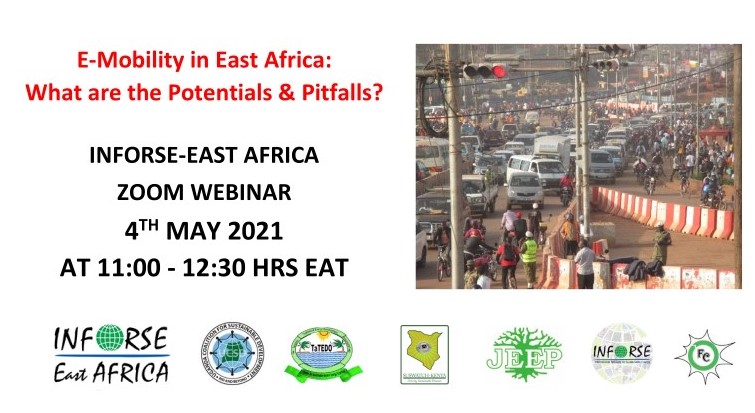E-Mobility in East Africa
- Category: News
- Published: Friday, 23 April 2021 13:25
- Written by Webmaster
- Hits: 1414

Program
Presentations followed by Discussions:
Moderator: Mr. Kimbowa Richard, INFORSE-East Africa Chairperson, Uganda Coalition for Sustainable Development
- Global perspectives and Overview of e-mobility initiatives in East Africa – Ms. Judith Adem Owigar, UN HABITAT
- State of E-mobility in Kenya or Tanzania or Uganda (State/City transport planning department)- TBC
- Practitioner experience – Mr. Alex Makaliwa, General Manager, Solar e-cycle, Nairobi, Kenya
- Lessons from Europe & Closing remarks - Mr. Gunnar Boye Olesen, INFORSE secretariat
The purpose of this webinar is to critically examine the applicability of E-Mobility in East Africa, based on experiences from practitioners in the region and beyond.
-What are the challenges to promotion of E-Mobility?
- To what extent are existing national and regional transport policies / strategies ripe to respond to promotion of E-Mobilitywhile meeting East Africa’s social, economicand environmental objectives, as well as the global urgency on climate action and clean air especially in the fast-growingcities?- What is the positioning of informal/semi-formal operators in the e-mobility transitions?
Background:The transport industry is growing rapidly in East Africa as it is globally. In Kenya, the vehicle population stood at over 2.5 million and the average number of newly registered units exceeded 200,000 annually since 2014.In Tanzania,the vehicle fleet multiplied 8-fold, with motorcycle increasing 33-fold, and cars more than 4-foldbetween2005-16. In Uganda, there were over 940,000 registered motorcycles and three-wheelers which makes up 59% of the total vehicle fleet in the country in 2016.
While supporting economic growth and social connectivity, the present transport scenario also brings about many problems such as air and noise pollution, congestion, increased demand for petroleum imports and consequent greenhouse gas (GHG) emissions. Transportation sector is estimatedby the Intergovernmental Panel on Climate Change (IPCC) to generate 23% of global energy-related greenhouse gas emissions.
But the good news is that promotion of public transportation and electric mobility could be one of the solutions. Electric mobility also known as E-mobility is the use of electricity to power the transport infrastructure as an alternative to fossil fuels. Electric mobility encompasses all the different types ofvehicles: cars, motorcycles, bicycles, 2- and 3-wheelers, buses, boats, and electrified rail. It is preferable that this electricity is from renewable energy sources such as hydro, geothermal, wind and solar tominimise overall emissions produced by the transport sector in cities across the globe every year, as well as curbing air and noise pollution.
INFORSE-East Africa organisations are collecting casesto a Catalogue ofLocal Sustainable Solutions in East Africa, where bicycles are already included. Should be e-mobility also part of these solutions in East Africa? We are also looking for good experiences and plans in the area. Please share with us your knowledge.
For more information contact: Mary Swai, TaTEDO/INFORSE-EA(This email address is being protected from spambots. You need JavaScript enabled to view it.), Kimbowa Richard UCSD Uganda (This email address is being protected from spambots. You need JavaScript enabled to view it.), Justus Munyoki Suswatch Kenya (justusmunyoki40gmail.com) and Prossie Nabiyonga, JEEP, Uganda (This email address is being protected from spambots. You need JavaScript enabled to view it.).
References: Reports: Republic of Kenya and GiZ, 2019. https://www.changing-transport.org/wp-content/uploads/2019_Electric_Mobility_in_Kenya.pdf. Bishop, T. B; et al., 2019. https://www.transaid.org/wp-content/uploads/2019/07/Transaid-Amend-TRL_2019_AFCAP_Uganda-motorcycles-report_FINAL.pdf. UNDP, 2017.Nationally Appropriate Mitigation Action (NAMA) for Bus Rapid Transit systems in Tanzania, NAMA Proposal for the urban transport sector in Tanzania (Draft).Local Sustainable Solutions in East Africa Catalogue: http://localsolutions.inforse.org/
